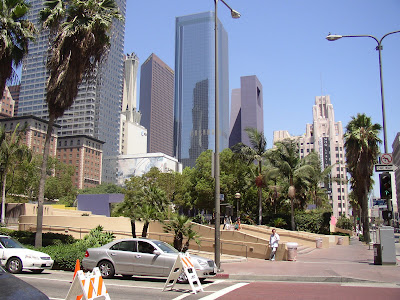The same thing happened to Bukowski, while he was scanning the shelves at the Los Angeles Public Library. One day, he picked up John Fante’s novel Ask the Dust and he couldn’t put it down. Fante wrote his novels from the perspective of an alter ego named Arturo Bandini: a strong-willed Italian-American who moves from his childhood home in Boulder, Colorado to downtown Los Angeles, to become a writer. Four novels outline Bandini's life from childhood to Hollywood: Wait Until Spring, Bandini (published in 1938), The Road to Los Angeles (written before all the others, but not published until 1985), Ask the Dust (published in 1939), and Dreams of Bunker Hill (published in 1982).
Ask the Dust chronicles the aspiring writer’s “lean days of determination” in the downtown neighborhood of Bunker Hill, in the 1930s. The first chapter charts his daily routine from Angel’s Flight to Olive Street and 5th, past the Biltmore to the Central Library, where he imagines seeing his name among the “big boys” on the spine of a book. Later, he meets Camilla Lopez in a bar on nearby Spring Street, before returning home to the Alta Loma Hotel, where he looks out over the city of Los Angeles and begins to write. Fante outlines his novel as follows: “Story of a girl I once loved who loved someone else, who in turn despised her.” Sounds simple enough, right? But the voice of Arturo Bandini – an ego-maniac without the ego – makes it unforgettable.
After we went on our Broadway Theater Tour on Saturday, we roamed the neighborhood to see where Fante lived and worked. Angel’s Flight (“the world’s shortest railway”) doesn’t operate anymore, and Bunker Hill exists only in name. The neighborhood was one of the city’s first suburbs – founded in the 1880s, when the streets were lined with beautiful Victorian houses. By 1940, it had become a slum. That year, Fante wrote a memorial for his old neighborhood: “Everything changes, and for better or worse the change came for me and the years have trickled away, and Bunker Hill is only a memory. But it lives on. It gave my thought food and drink. It sated my hunger for life...”
In 1955, the city started a LONG redevelopment project (still ongoing…) to turn the neighborhood into a business district. Now, instead of Victorian houses, there are skyscrapers looming above Pershing Square. In the early 80s, around the same time that Fante wrote his last Bandini novel, Charles Bukowski and publisher City Lights introduced Ask the Dust to a new generation of readers. Today it is considered one of the best early examples of Los Angeles literature – published the same year as Raymond Chandler’s The Big Sleep, John Steinbeck’s The Grapes of Wrath, Aldous Huxley’s After Many a Summer Dies the Swan, and Nathanael West’s The Day of the Locust.
Despite all the changes, there are still fans who are celebrating Fante’s legacy and what’s left of his Bunker Hill. This summer, an L.A.-based company called Esotouric started offering bus tours of Fante and Bukowski’s downtown haunts. The building where Fante wrote Ask the Dust is still there. So is the building where Bukowski wrote Women… though just barely. Both buildings, which are vacant except for transient squatters, have been slated for demolition. For information and photos, see the Esotouric founder’s blog: Two or Three Things I Know about Her.
This blog also led me to a site called “Nobody Reads in L.A.” I swear I visited the website a few days ago, but now it seems to be gone. Maybe that’s proof positive of the title’s cynical theory? Too bad, because there are plenty of great books written in and about Los Angeles. I just finished a 1928 book called Spider Boy by Carl Van Vechten, one of the first novels to skewer the Hollywood myth. I’m convinced that it was a major inspiration for Billy Wilder’s film Sunset Boulevard. Other recent discoveries: If He Hollers, Let Him Go by Chester Himes (a glimpse into WWII-era San Pedro) and Play It As It Lays by Joan Didion (forerunner of Bret Easton Ellis’s Less than Zero). These are some of the best works of fiction I’ve read in years… maybe since I was in college, chasing Bukowski with other fierce-minded writers like Knut Hamsun, Louis-Ferdinand Celine, Joseph Heller, William Burroughs, Hunter S. Thompson, Hubert Selby Jr., Larry Crews… My memories of reading these authors for the first time are as vivid as Fante’s memories of Bunker Hill. Put simply: They fed my hunger for life.
 This is a mural near the intersection of 3rd and Broadway. The subject is actor Anthony Quinn... who I think looks a bit like Charles Bukowski.
This is a mural near the intersection of 3rd and Broadway. The subject is actor Anthony Quinn... who I think looks a bit like Charles Bukowski. Pershing Square - then (photo from the Los Angeles Public Library)
Pershing Square - then (photo from the Los Angeles Public Library) Pershing Square - now
Pershing Square - now Angel’s Flight - then (photo from www.yesterdayla.com)
Angel’s Flight - then (photo from www.yesterdayla.com) Angel’s Flight - now
Angel’s Flight - now Bunker Hill steps
Bunker Hill steps Los Angeles Public Library (view from the top of Bunker Hill)
Los Angeles Public Library (view from the top of Bunker Hill) Just to give you a sense of how big this library really is.... here's the stairwell to the lower levels.
Just to give you a sense of how big this library really is.... here's the stairwell to the lower levels.
Behind the modern art sculpture is the Westin-Bonaventure Hotel, recognizable from the beginning of "The Terminator." Zoom in and you can see that it has elevator shafts on the outside of the building. (View from the top of Bunker Hill)
No comments:
Post a Comment